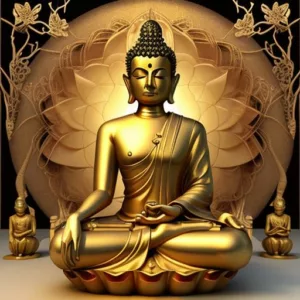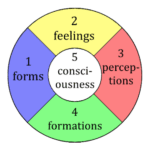Buddhism is a salvific religion founded by Gautama Buddha in ~480 BC. Essential concerns are:

- Liberation from suffering
- Not-self of the individual
- 5 skandhas as composition of illusory self
- 12 nidanas as the mechanism of karma
- Bodhisattva ideal in the Mahayana path
- Study and meditation on emptiness
- Bodhicitta – awakened heart of compassion and wisdom
I first found Buddhism several decades ago. These were, for the most part, the concepts I was introduced to. I’m happy to revisit them and deepen my knowledge while explaining what I know. They are pretty involved philosophies, so we’ll only cover a part here, then link to deeper explanations if you’re interested.
14 Little-Known Facts About Buddhism
Here
While the religion is a well-established religion with a rich history, there are many fascinating details that often go unnoticed. Here are 14 little-known facts to broaden your understanding:
- Monastic Life Isn’t Mandatory: While monasticism plays a significant role in some traditions, Buddhism isn’t solely focused on monastic life. Lay practitioners can follow Buddhist teachings and achieve enlightenment while living a secular life.
- Ordination for Women: Contrary to popular belief, some Buddhist traditions have a long history of female ordination. Theravada may be known for its limited role for women, but Mahayana traditions like Zen and Tibet have lineages of female teachers and monastics.
- Buddhist Universities: Nalanda University, established in the 5th century CE in India, was a renowned center for Buddhist learning. It attracted scholars from across Asia and offered a vast curriculum, including philosophy, medicine, and astronomy.
- Buddhist Martial Arts: Many martial arts like Kung Fu, Karate, and Taekwondo have roots in Buddhist practices. These disciplines emphasize self-defense, mindfulness, and inner peace, reflecting Buddhist principles.
- Secular Applications: Mindfulness techniques developed in the system have found widespread application in modern society. They are used to manage stress, improve focus, and enhance overall well-being in various fields, including healthcare and education.
- Buddhist Art and Architecture: From majestic temples in Angkor Wat to intricate thangkas (Tibetan scroll paintings), Buddhist art forms are a vibrant expression of faith and philosophy. These artistic creations serve as teaching tools and inspire contemplation.
- Scientific Parallels: Studies on the meditation practices have shown positive impacts on brain function and emotional regulation, aligning with some core Buddhist teachings on the mind and its potential.
- Diverse Deities: While often considered a non-theistic religion, some Buddhist traditions incorporate deities. These figures represent qualities or aspects of enlightenment and are not worshipped as gods in the traditional sense.
- Engaged Buddhism: This modern movement emphasizes applying Buddhist principles to address social and environmental issues. It encourages practitioners to take action in the world, promoting social justice and environmental sustainability.
- Buddhist Humor: Buddhist teachings incorporate humor and playful stories to convey profound ideas. Zen koans, for example, use paradoxical questions to challenge our logical thinking and open us to deeper understanding.
- Buddhist Cuisine: Vegetarianism and veganism are widely practiced in some Buddhist traditions, reflecting the principle of non-violence (ahimsa). This has led to the development of unique and flavorful plant-based cuisines in Buddhist cultures.
- Death Rituals: Buddhist death rituals focus on helping the deceased transition to their next life. Practices vary across traditions but often involve chanting, offerings, and meditations aimed at generating merit for the departed.
- Global Community: It is one of the world’s largest religions, with followers across the globe. It continues to evolve and adapt to different cultures, offering a diverse tapestry of beliefs and practices.
- Ongoing Exploration: The religion is a tradition rich in scholarship and philosophical inquiry. New interpretations and understandings of the Buddha’s teachings continue to emerge, ensuring its relevance for future generations.
Table of Contents
Buddhism Summary Table
| Entity | Description |
|---|---|
| Buddhism | A dharmic religion or spiritual tradition originating in ancient India, founded by Siddhartha Gautama and based on his teachings. |
| Siddhartha Gautama | The founder of Buddhism, who achieved enlightenment and became known as the Buddha. |
| Four Noble Truths | The foundation of Buddhist teachings, outlining the nature of suffering, its cause, the end of suffering, and the path to ending suffering. |
| Eightfold Path | A framework for ethical conduct, mental discipline, and wisdom, leading to the end of suffering. |
| Karma | The principle of cause and effect, where intentional actions (good or bad) have consequences. |
| Rebirth | The cycle of birth, death, and rebirth, influenced by karma. |
| Nirvana | The ultimate goal in Buddhism, a state of liberation from suffering and the cycle of rebirth. |
| Theravada Buddhism | A major branch of Buddhism emphasizing monastic life, individual liberation, and following the Pali Canon scriptures. |
| Mahayana Buddhism | Another major branch of Buddhism emphasizing the Bodhisattva path, helping all beings achieve enlightenment. |
| Vajrayana Buddhism | A branch of Mahayana Buddhism known for its esoteric practices, rituals, and visualizations. |
Relationships
| Relationship | Description |
|---|---|
| Founded by | Siddhartha Gautama’s teachings and enlightenment experiences form the basis of Buddhism. |
| Explains | The Four Noble Truths are the core principles that Buddhism seeks to explain and address. |
| Offers | The Eightfold Path is a practical guide offered by Buddhism to achieve the end of suffering. |
| Governs | Karma is a universal principle in Buddhism that governs the consequences of actions. |
| Leads to | Karma influences the conditions of rebirth within the cycle of samsara. |
| Ultimate Goal of | Nirvana is the state of liberation that Buddhism aims to achieve, breaking free from the cycle of suffering and rebirth. |
| Main Branch of | Theravada is one of the two main branches that emerged from early Buddhism. |
| Main Branch of | Mahayana is the other main branch, known for its focus on the Bodhisattva path. |
| Emerged from | Vajrayana developed from Mahayana Buddhism, incorporating unique tantric practices. |
Additional Notes:
- Buddhism encompasses various schools and traditions, each with its own interpretations and practices.
- Buddhist teachings emphasize ethical conduct, mindfulness, meditation, and wisdom cultivation.
- The concept of Buddhahood is central to Buddhism, representing a state of complete enlightenment.
Unveiling the Depths of Buddhism: A Journey of Self-Discovery
Buddhism, more than just a religion or philosophy, is a multifaceted journey of self-discovery. With roots reaching back to ancient India, it offers a unique perspective on life, suffering, and the potential for liberation. This guide delves into the core principles, practices, and diverse branches of Buddhism, equipping you to embark on your own exploration.
The Journey Begins: Unveiling the Founder and Core Teachings
The journey begins with Siddhartha Gautama, a prince who, shaken by the realities of human suffering, embarked on a quest for understanding. After years of seeking, he attained enlightenment and became known as the Buddha, the “awakened one.” His teachings, the foundation of Buddhism, are encapsulated in the Four Noble Truths:
- The Truth of Suffering (Dukkha): Life is inherently characterized by suffering, dissatisfaction, and impermanence.
- The Truth of the Cause of Suffering (Samudaya): Suffering arises from craving and clinging, our attachment to impermanent desires.
- The Truth of the End of Suffering (Nirodha): Liberation from suffering, known as Nirvana, is achievable.
- The Truth of the Path to the End of Suffering (Magga): The Eightfold Path, a practical framework, guides us towards the end of suffering.
The Eightfold Path, comprising Right View, Right Intention, Right Speech, Right Action, Right Livelihood, Right Effort, Right Mindfulness, and Right Concentration, outlines a roadmap for ethical conduct, mental discipline, and wisdom cultivation. This path, like a map leading to a mountain peak, offers a practical guide to navigate life’s challenges and cultivate inner peace.
Karma and Rebirth: Understanding Cause and Effect
Karma, the principle of cause and effect, weaves a delicate tapestry within Buddhist thought. Every intentional action, good or bad, carries consequences that shape our future experiences. This concept, however, isn’t about punishment or reward, but about understanding the interconnectedness of our actions and their outcomes.
Rebirth, the cycle of birth, death, and rebirth, is another key concept. Influenced by karma, we are continuously reborn until we achieve liberation through the path outlined by the Buddha.
Nirvana: The Ultimate Goal
Nirvana, often misunderstood as a blissful paradise, is not a destination but rather a state of liberation. It signifies the complete cessation of suffering, the extinguishment of craving and clinging, and a state of profound peace and wisdom. Achieving Nirvana brings an end to the cycle of rebirth and allows individuals to experience their true nature, free from suffering.



Major Branches of Buddhism
Over time, Buddhism diversified into various branches, each with its own interpretations and practices:
- Theravada Buddhism: Emphasizing individual liberation through strict adherence to the Buddha’s teachings and monastic life, Theravada Buddhism is widely practiced in Southeast Asia.
- Mahayana Buddhism: Characterized by the Bodhisattva ideal, Mahayana emphasizes helping all beings achieve enlightenment. This branch is prominent in East Asia and includes traditions like Zen and Pure Land Buddhism.
- Vajrayana Buddhism: Emerging from Mahayana, Vajrayana incorporates esoteric practices, rituals, and visualizations as a means to achieve enlightenment. This branch is prominent in Tibet, Bhutan, and Mongolia.
Buddhist Practice: Mindfulness & Virtue
At the heart of Buddhist practice lies meditation, the cultivation of present-moment awareness and mental clarity. Through various meditation techniques, individuals train their minds to observe thoughts and emotions without judgment, fostering inner peace and insight.
Ethical conduct, another cornerstone of Buddhist practice, is embodied in the Five Precepts: abstaining from killing, stealing, lying, sexual misconduct, and intoxicants. These principles serve as a framework for living a compassionate and responsible life, minimizing harm to oneself and others.
Three Jewels, Mahayana View, and Paramitas
For practitioners, the Three Jewels – Buddha, Dharma (the teachings), and Sangha (the community) – serve as sources of refuge and inspiration. The Mahayana view introduces the Bodhisattva path, where individuals dedicate themselves to helping all beings achieve enlightenment before reaching their own. The six Paramitas – generosity, patience, ethical conduct, diligence, meditation, and wisdom – represent qualities cultivated on the Mahayana path to enlightenment.
Buddhist Schools
Buddhism encompasses a diverse range of schools and traditions, each with its unique interpretations and practices. Zen Buddhism emphasizes mindfulness and meditation, while Pure Land Buddhism focuses on faith and devotion. Exploring these schools reveals the richness and adaptability of Buddhism across different cultures and throughout history.
Lineage figures in Buddhism
Major Figures: teaching the Path
Beyond the foundational teachings and diverse branches, the history boasts a rich tapestry of influential figures who have shaped its history and practice. Here are a few prominent examples:
- Nagarjuna (2nd century CE): A renowned philosopher and scholar, Nagarjuna is considered the founder of Madhyamaka, a central school of Mahayana Buddhism. He is known for his profound understanding of emptiness (shunyata), a key concept in Mahayana thought. His philosophical contributions significantly impacted the development of Buddhist thought and continue to be studied and debated today.
- Shantideva (8th century CE): Renowned for his compassionate teachings and poetic works, Shantideva is a revered figure in Mahayana Buddhism. His magnum opus, the “Bodhicharyavatara” (Guide to the Bodhisattva’s Way of Life), is a practical guide for cultivating compassion, wisdom, and altruism on the path to enlightenment.
- Marpa Lotsawa (10th-11th century CE): A pivotal figure in the transmission of Tantra from India to Tibet, Marpa Lotsawa undertook arduous journeys to receive teachings from renowned Indian masters. He tirelessly translated texts and established lineages that continue to flourish today, playing a crucial role in shaping Tibetan Buddhism.
- Milarepa (11th-12th century CE): A renowned Tibetan poet and yogi, Milarepa is revered for his unwavering devotion and perseverance on the path to enlightenment. His life story, filled with challenges and triumphs, serves as an inspiration for many practitioners, and his songs continue to be cherished for their poetic beauty and spiritual insights.
These are just a few examples of the many influential figures who have enriched the dharma throughout history. Each individual, through their teachings, practices, and contributions, has helped shape and preserve the vast and vibrant tradition of Buddhist thought and practice.
How to meditate like a yogi
and enter profound samadhi
Tantra: the Esoteric Path
Tantra, meaning “loom” or “woven together,” is a multifaceted aspect of Vajrayana Buddhism. It encompasses a complex system of practices and rituals involving deities, mantras, visualizations, and symbolism. Unlike the more analytical approaches of other Buddhist schools, Tantra emphasizes direct experience and the awakening of innate potential through transformative practices.
While often misunderstood or shrouded in secrecy, Tantra is not a separate religion but rather a unique approach within Vajrayana Buddhism. It is intended for qualified practitioners under the guidance of a qualified teacher due to the complexity and potential for misinterpretations.
Some key elements of Tantra include:
- Deities: Vajrayana practitioners visualize themselves as specific Buddhas or enlightened beings, embodying their qualities and harnessing their power to aid in their spiritual development.
- Mantra recitation: Mantras are sacred syllables or phrases repeated with focused attention. They are believed to have the power to purify the mind, connect with deeper levels of consciousness, and awaken inner wisdom.
- Visualization: Tantric practitioners engage in elaborate visualizations, imagining themselves in specific environments or interacting with deities to cultivate transformative experiences.
Tantra, due to its unique nature, is not for everyone. However, for those who are called to this path and find a qualified teacher, it offers a powerful and transformative approach to achieving enlightenment.
Secrets of Meditation for Anxiety
Like millions of people, you may have suffered from anxiety for years. Meditation, yoga, peaceful music – it never works. It takes too long, and it’s not stable. Why? Because peace is treated as a cause for freedom, but it’s not – it’s the result. The cause to free yourself from anxiety is completely different.
Click now to Overcome Anxiety for good.
The Spread of Buddhism
From its humble beginnings in India, Buddhism embarked on a remarkable journey, spreading across vast distances and adapting to diverse cultures. Here’s a glimpse into this remarkable story:
- Early Spread (3rd century BCE – 5th century CE): During this period, Buddhism primarily spread through trade routes and royal patronage. Emperor Ashoka, a powerful ruler in India, played a pivotal role in promoting Buddhism through missionary activities and the construction of stupas (religious monuments). Buddhism reached Sri Lanka, Southeast Asia, and Central Asia during this time.
- Mahayana Expansion (5th – 12th century CE): Mahayana Buddhism gained prominence and spread to China, Korea, and Japan. Influential figures like Xuanzang, a Chinese monk who undertook a legendary pilgrimage to India, played a crucial role in transmitting Buddhist texts and teachings. This period saw the development of distinct schools like Zen and Pure Land Buddhism.
- Tibetan Buddhism (7th – 14th century CE): Buddhism entered Tibet in the 7th century CE and flourished under royal patronage. It blended with local Bon traditions, giving rise to a unique form of Buddhism known as Vajrayana. This branch spread to neighboring regions like Mongolia and Bhutan.
- Modern Developments (19th century – Present): Through translations, scholarship, and the work of influential teachers, Buddhism has experienced a global resurgence in the 20th and 21st centuries. It continues to attract

May all beings be happy
May all beings be peaceful
May all beings be safe
May all beings awaken to the light of their true nature
May all beings be free







